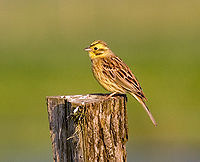
Yellowhammer
About this schools Wikipedia selection
The articles in this Schools selection have been arranged by curriculum topic thanks to SOS Children volunteers. A good way to help other children is by sponsoring a child
| Yellowhammer | |
|---|---|
 |
|
| Conservation status | |
|
Least Concern
|
|
| Scientific classification | |
| Kingdom: | Animalia |
| Phylum: | Chordata |
| Class: | Aves |
| Order: | Passeriformes |
| Family: | Emberizidae |
| Genus: | Emberiza |
| Species: | E. citrinella |
| Binomial name | |
| Emberiza citrinella Linnaeus, 1758 |
|
The Yellowhammer, Emberiza citrinella, is a passerine bird in the bunting family Emberizidae, which breeds across Europe and much of Asia. The Yellowhammer was introduced to New Zealand in 1862 and is now common and widespread there. It is probably more abundant in New Zealand now than in Europe where is in serious decline, (in the UK the species fell by 54% between 1970 and 2003). In Europe and Asia most birds are resident, but some far northern birds migrate south in winter. It is common in all sorts of open areas with some scrub or trees and form small flocks inwinter .
The Yellowhammer is a robust 15.5-17 m long bird, with a thick seed-eater's bill. The male has a bright yellow head, yellow underparts, and a heavily streaked brown back. The female is much duller, and more streaked below. The familiar, if somewhat monotonous, song of the cock is often described as A little bit of bread and no cheese.
Its natural diet consists of insects when feeding young, and otherwise seeds. The nest is on the ground. 3-6 eggs are laid, which show the hair-like markings characteristic of those of buntings.
It has been claimed by Karl Czerny, that the Yellowhammer's song was the inspiration for the "fate" motif of the Symphony No. 5 by Ludwig van Beethoven.
Habitat
It is mostcommonly found on lowland arable and mixed farmland, probably due the greater availability of seeds. It nests in hedges, patches of scrub and ditches, especially if these have a wide grass margin next to it, and a cereal crop next to the margin. Hedges of up to 2 metres are preferred, and they will not nest until it is in full leaf, building the nest next to the hedge if it is built before this. In winter the flocks feed at good seed sites, such as. newly sown fields, over-wintered stubbles.
Diet
Seeds of:
- Cereal, grasses (eg Meadow Grass, Fescue, Ryegrass), Common Nettle, dock, knotgrass Polygonum aviculare, Fat Hen Chenopodium album, Common Chickweed Stellaria media, Mouse-ear Cerastium, Bramble, Vetches, Clover, Forget-me-not, Dandelion, Knapweed, Sow-thistle Cicerbita, Yarrow, Plantains Plantago
Invertebrates mainly, but not exclusively taken through the breeding season:
- Springtails, mayflies, grasshopper, cockroach, earwigs, bugs Hemiptera, lacewings, caddis flies, sawflies, spiders, woodlice, millipedes, caterpillars, flies, beetles, earthworms, snails
They are more able to feed on the slower moving invertebrates.
